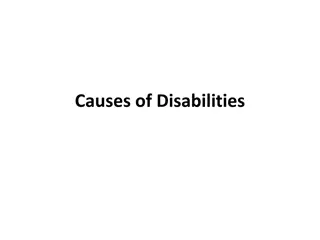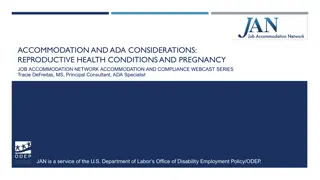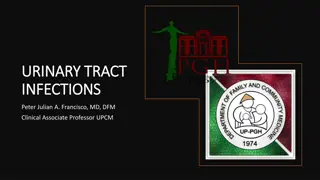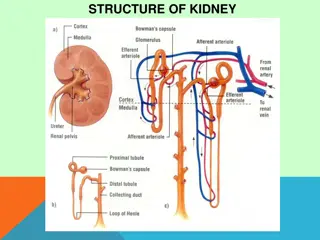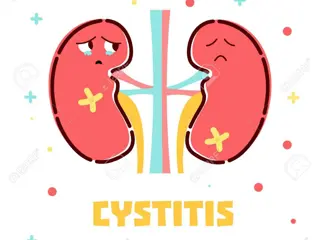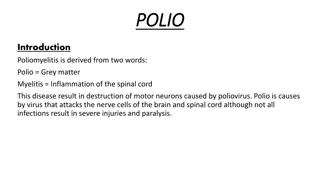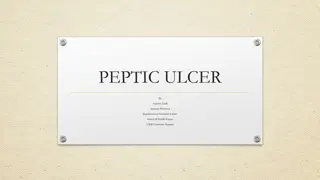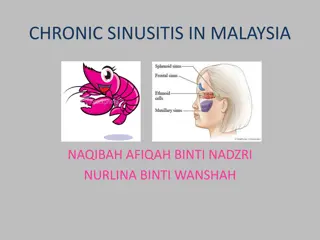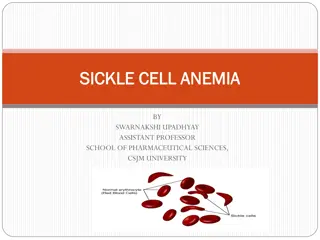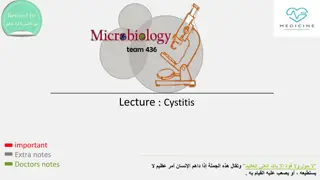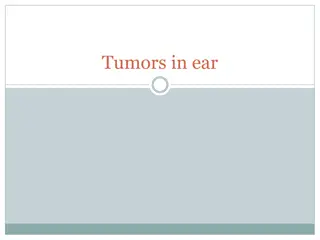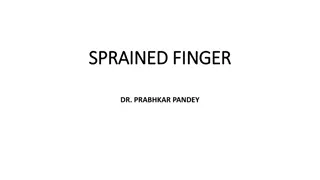Cystitis: Causes, Symptoms, and Management
Cystitis is a common urinary tract infection affecting both men and women, characterized by inflammation of the bladder mucosa. This article covers the definition, pathogenesis, risk factors, causative organisms, types, diagnostic methods, and treatment options for cystitis, emphasizing the importance of recognizing the different presentations in various age groups. It also explores the classification of UTIs, including lower and upper tract infections. Understanding the prevalence, symptoms, and potential complications of cystitis is crucial for effective management.
Download Presentation

Please find below an Image/Link to download the presentation.
The content on the website is provided AS IS for your information and personal use only. It may not be sold, licensed, or shared on other websites without obtaining consent from the author.If you encounter any issues during the download, it is possible that the publisher has removed the file from their server.
You are allowed to download the files provided on this website for personal or commercial use, subject to the condition that they are used lawfully. All files are the property of their respective owners.
The content on the website is provided AS IS for your information and personal use only. It may not be sold, licensed, or shared on other websites without obtaining consent from the author.
E N D
Presentation Transcript
Cystitis Renal Block PROF.HANAN HABIB Department of Pathology, Microbiology Unit
Objectives 1-Define the term cystitis and recall who commonly gets cystitis. 2- Describe the pathogenesis and risk factors of cystitis. 3- List the most common causative organisms of cystitis 4- Recall the different types of cystitis ( infectious and non- infectious). 5- Recognize that venereal diseases can present with cystitis. 6- Describe the laboratory diagnostic of cystitis 7- Recall the antimicrobial agents suitable for the treatment and prevention of cystitis.
Introduction Urinary Tract infection (UTI) divided into upper and lower urinary tract infections Patient presents with urinary symptoms and significant bacteriuria= 105 bacteria/ml Asymptomatic bacteriuria when the patient presents with significant bacteria in urine but without symptoms
Prevalence of Bacteriuria in different age groups 30 25 20 female male 15 10 5 0 0-3 4 14 15-29 30-64 65-85 >85
Classification Lower UTIs Cystitis (infection of the bladder; superficial mucosal infections) Urethritis (sexually transmitted pathogens) - urethritis in men & women Prostatitis and Epididymitis Upper UTIs Acute pyelonephritis Chronic pyelonephritis Uncomplicated UTI (empirical therapy is possible) Complicated UTI (nosocomial UTI, relapses, structural or functional abnormalities )
http://t2.gstatic.com/images?q=tbn:ANd9GcTv87UcHoPklVGA41kHOOqo2WjDvlyO_EVTMk4iFUFq8xCYDwhttp://t2.gstatic.com/images?q=tbn:ANd9GcTv87UcHoPklVGA41kHOOqo2WjDvlyO_EVTMk4iFUFq8xCYDw Cystitis In women : cystitis is common due to a number of reasons : - Short urethra - Pregnancy - Decreased estrogen production during menopause. In men: mainly due to persistent bacterial infection of the prostate. In both sexes: common risk factors are : - Presence of bladder stone - Urethral stricture - Catheterization of the urinary tract - Diabetes mellitus
Pathogenesis of cystitis Due to frequent irritation of the mucosal surfaces of the urethra and the bladder. Infection results when bacteria ascends to the urinary bladder . These bacteria are residents or transient members of the perineal flora, and are derived from the large intestine flora. Toxins produced by uropathogens. Conditions that create access to bladder are: - Sexual intercourse due to short urethral distance. -Uncomplicated UTI usually occurs in non pregnant , young sexually active females without structural or neurological abnormalities
Pathogenesis of cystitis -Risk factors : - Catheterization of the urinary bladder , instrumentation - Structural abnormalities - Obstruction -Haematogenous through blood stream from other sites of infection (less common).
http://t2.gstatic.com/images?q=tbn:ANd9GcTv87UcHoPklVGA41kHOOqo2WjDvlyO_EVTMk4iFUFq8xCYDwhttp://t2.gstatic.com/images?q=tbn:ANd9GcTv87UcHoPklVGA41kHOOqo2WjDvlyO_EVTMk4iFUFq8xCYDw Etiologic agents E.coli is the most common (90%) cause of cystitis. Other Enterobacteriaceae include (Klebsiella pneumoniae, Proteus spp.) Other gram negative rods eg. P.aeroginosa. Gram positive bacteria: Enterococcus faecalis, group B Streptococcus and Staphylococcus saprophyticus {honeymoon cystitis}. Candida species Venereal diseases (gonorrhea, Chlamydia) may present with cystitis. Schistosoma haematobium in endemic areas.
Pathogens involved Uncomplicated UTI E. coli Enterobacteriaceae 16% Enterococcus spp 20% Pseudomonas spp <1% S. aureus Complicated UTI E. coli Enterobacteriaceae Pseudomonas spp Acinetobacter spp judge, often multi-resistant strains) 64% (% is not possibl e to <1% Special cases S. epidermidis S. saprophyticus Yeasts (catheter related) Viruses (Adenovirus, Varicella) Chlamydia trachomatis
Clinical presentation http://t2.gstatic.com/images?q=tbn:ANd9GcTv87UcHoPklVGA41kHOOqo2WjDvlyO_EVTMk4iFUFq8xCYDw Symptoms usually of acute onset. Dysuria (painful urination) Frequency (frequent voiding) Urgency (an imperative call for toilet) Hematuria (blood in urine) in 50% of cases. Usually no fever.
http://t2.gstatic.com/images?q=tbn:ANd9GcTv87UcHoPklVGA41kHOOqo2WjDvlyO_EVTMk4iFUFq8xCYDwhttp://t2.gstatic.com/images?q=tbn:ANd9GcTv87UcHoPklVGA41kHOOqo2WjDvlyO_EVTMk4iFUFq8xCYDw Vaginitis (5%) Candida spp. T. vaginalis Cystitis (80%) E. coli, S. saprophyticus Proteus spp. Klebsiella spp. Urethritis (10-15%) C. trachomatis, N. gonorrhoeae H. simplex Other bacteria? Dysuria and frequency Non-infectious (<1%) Hypoestrogenism Functional obstruction Mechanical obstruction Chemicals
How to differentiate between cystitis and urethritis ? Cystitis is of more acute onset More sever symptoms Pain, tenderness on the supra-pubic area. Presence of bacteria in urine (bacteriuria) Urine cloudy, malodorous and may be bloody
Differential diagnosis (types of cystitis) Non-infectious cystitis such as: 1. Traumatic cystitis in women 2. Interstitial cystitis ( unknown cause, may be due to autoimmune attack of the bladder) 3. Eosinophilic cystitis due to S. haematobium Hemorrahagic cystitis due to radiotherapy or chemotherapy.
Laboratory diagnosis of cystitis 1. Specimen collection: Most important is clean catch urine [Midstream urine (MSU)] to bypass contamination by preneal flora and must be before starting antibiotic. Supra-pubic aspiration or catheterization may be used in children. Catheter urine should not be used for diagnosis of UTI.
2- Microscopic examination: About 90% of patients have > 10 WBCs /cu.mm Gram stain of uncentrifuged sample is sensitive and specific. One organism per oil-immersion field is indicative of infection. Blood cells, parasites or crystals can be seen
3- Chemical screening tests: Urine dip stick rapid, detects nitrites released by bacterial metabolism and leukocyte esterase from inflammatory cells. Not specific. 4- Urine culture: important to identify bacterial cause and antimicrobial sensitivity . Quantitative culture typical of UTI ( >100,000 /cumm) Lower count (<100,000 or less eg. 1000/cumm ) is indicative of cystitis if the patient is symptomatic.
Quantitative urine culture Using 0.001/ml loop 1 colony = 1000 CFU/ml 100 colonies = 100,000 CFU/ml
Recurrent cystitis Three or more episodes of cystitis /year Requires further investigations such as Intra-Venous Urogram (IVU) or Ultrasound to detect obstruction or congenital deformity. Cystoscopy required in some cases.
Treatment of cystitis Empiric treatment commonly used depending on the knowledge of common organism and sensitivity pattern. Treatment best guided by susceptibility pattern of the causative bacteria. Common agents: Ampicillin, Ampicillin-Clavulanic acid , Cephradine, Ciprofloxacin, Norfloxacin, Gentamicin or TRM-SMX.
Duration of treatment: three days for uncomplicated cystitis 10-14 days for complicated and recurrent cystitis. Prophylaxis required for recurrent cases by Nitrofurantoin or TRM-SMX. Prevention : drinking plenty of water and prophylactic antibiotic.










